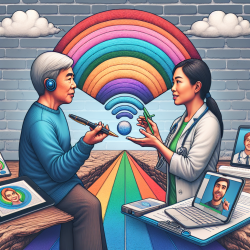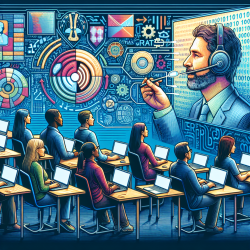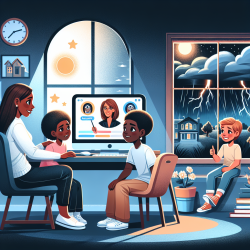Introduction
In today's rapidly evolving digital world, the integration of technology into healthcare and educational services is not just a luxury but a necessity. The research article, "Crossing the digital divide: a veteran affairs program to distribute video-enabled devices to patients in a supportive housing program," offers valuable insights into how technology can enhance service delivery. As a speech-language pathologist, understanding and applying these findings can significantly improve the outcomes of teletherapy sessions for children.
Understanding the Research
The study conducted by the Veteran Health Affairs (VA) focused on distributing video-enabled tablets and cellphones to veterans in the HUD-VASH program. This initiative aimed to bridge the digital divide and ensure continued healthcare engagement during the COVID-19 pandemic. The results were compelling: there was a notable increase in both in-person and video-based engagements, while telephone engagements decreased. This shift underscores the potential of video-enabled devices to enhance communication and service delivery.
Implications for Speech-Language Pathologists
For practitioners in speech-language pathology, these findings highlight several key takeaways:
- Enhanced Engagement: Video-enabled devices can significantly improve client engagement. The visual component of video calls can enhance interaction, making sessions more effective compared to audio-only calls.
- Accessibility: Providing clients with the necessary technology can remove barriers to access, ensuring that all children, regardless of their socio-economic background, receive the therapy they need.
- Flexibility: The use of video technology allows for more flexible scheduling and the possibility of conducting sessions in a variety of settings, accommodating the needs of both the therapist and the client.
Encouraging Further Research
While the study provides a solid foundation, it also opens the door for further research in the field of speech-language pathology. Practitioners are encouraged to explore:
- The long-term impacts of video-enabled devices on therapy outcomes.
- Comparative studies between video-based and in-person therapy sessions to evaluate efficacy.
- Innovative ways to integrate technology into therapy sessions to enhance learning and engagement.
Conclusion
The VA's initiative serves as a model for expanding access to digital health tools, demonstrating the potential to improve engagement and outcomes. As speech-language pathologists, embracing technology and advocating for its integration into therapy can lead to more effective and accessible services for children. By leveraging these insights, practitioners can ensure that they are not only keeping up with the times but also providing the best possible care for their clients.
To read the original research paper, please follow this link: Crossing the digital divide: a veteran affairs program to distribute video-enabled devices to patients in a supportive housing program.










